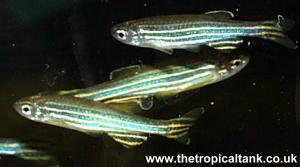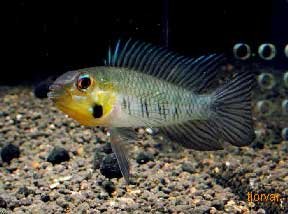Discus – Symphysodon aequifasciata
Popular Discus (Red discus, Fairy fish)
Discus, Pompadour, Poisson-Disque (Red discus, Royal blue discus)
Latin name: Symphysodon discus
Family: Tilapia – Cichlidae
Distribution: Amazon (South America)
Adult fish length: 15-20 cm
Discus is the largest fish in the fish plate. This fish are very high drive, very nice inside; mouth small, oblique cover height.
The background color is golden brown or chestnut, plum color. There are still light blue iridescent clearly see the side of the fish.
There are seven dark vertical stripes, 5th stripe in the middle of the body is the widest stripe and darker stripes.
Red fish with light blue wavy lines and iridescent, extending up one part of the tree back and anus. Other parts blue.
First is the makeup of the sparkling blue or translucent.
Fish red disc: the original body and the dorsal, anal, red-brown.
Aquarium:
Swimming should be very wide and deep water 45-60cm.
pH: 6 to 6.8.
Temperature: 22-30 degrees C.
Breeding groups of 5-6 or more.
Food: Provide cast, worm, net-net, the shredded beef, synthetic dry food, should be changed regularly to ensure all the nutrients …
Fed: Fish greedy, but should only eat two times a day with just enough. For clean food. After feeding (about 5-10 minutes), remove all the leftovers. Can fish fasted 24-48 hours.
Reproduction:
Hard disk fish breeding, artificial breeding tank should be slightly acidic pH (pH = 5.5-6).
Males: to shape, head slightly bent, saggy ventral, abdomen region adjacent fins indentation looks very clear, aggressive activities than females.
Females: usually smaller than males, genital spines protruding short (# 3mm), divided into 2 lobes pointed and slightly curved back.
Mating period occurs within 7-10 Nagy. pair will split a corner, mouth washing where birth. Often side by mouth, turned up tail, chasing each other, chase other children near them. Then we double wave pool, tangerine wrap together. Prior to a few days, both the phenomenon of shudder, shaking the whole body, folded fin, sometimes standing still in place, less prey. When born, the first ten to 45 degrees. Now genital spines visible, and vibrant color. Females lay eggs vertically, from the bottom up. Males also the route that information to fertilize the egg. Often 70-80 150 eggs, sometimes more.
Fertilized egg in color throughout. Eggs fertilized cloudy. After 24 hours, the fertilized egg turns white or gray. At 30 degrees C the eggs hatch within 55-57 hours. While this fish father and mother turns to fan the eggs to get enough fresh air. Hatching rate: 60-90%.
So for spawning quiet (crank, cover the fish tank).
Government fry: After the eggs hatch into larvae, fish parents helped their children to a different location. Thanks greasy strands at the top, stick fry tank or a price. Fish not swimming and living nature reserve in the yolk sac of the lower abdomen. Children are to be dropped will be the parents brought back again.
After 60 hours, the fry can swim the parental fish around. Fish live their by eating mucus secreted from the parents for 12-15 days. After that, I started to eat small organisms in the water. About 18 days, the fry to eat artificial food. After 21 days we can go in search of food.
Fry for about 1,2-2mm; fish after 1 week 3mm long. About 2 weeks old, fish 1cm long, straight striped body, brown or gray. By 18 days, 1.5 cm long fish, the dorsal and ventral fins black, color. About 5-6 weeks, about 2-2.5 cm long fish, shaped like the adults, but it is not clear colors. After 3 months, the 6-7cm long and color is evident, but it was not until 5-6 months, new fish have colorful adult fish.
For the first time, from day 7, so feeding daphnia (Moina) young (small), tick one eye (Cyclops) young, several times a day, avoid eating too full. Food should be distributed evenly throughout tank, avoiding large fish paintings eat. Followed by up to two and a half months, the feeding water fleas (Daphnia). 3-4 months for the fish eat additional provision toss, worms only. Then to eat net net, the small guppies.
In the first few weeks, so keep the water temperature 29-30 degrees C. Light about 18 hours. But should not the light is too bright.
Blue discus, discus bleu
Latin name: Symphysodon aequifasciata haraldi
Family: Tilapia – Cichlidae
Distribution: Amazon (South America)
Adult fish length: up to 12 cm and more
Brown discus, discus brun
Latin name: Symphysodon aequifasciata axelrodi
Family: Tilapia – Cichlidae
Distribution: Amazon (South America)
Adult fish length: 14 cm
Green discus, Discus vert
Latin name: Symphysodon aequifasciata aequifasciata
Family: Tilapia – Cichlidae
Kinds of fish with this color is rare.
Common diseases in discus
Illed fishes usually have dark black, swimming lethargic, or in the bottom of the tank or to sit out of the water, the flag on the tail and folded flag under corrosion. Individuals suffering from anorexia. Common diseases are:
– Achlya and Saprolegnia fungi (mold): causes small white spots on the fish body. Copper sulfate can be used for disinfection of fish with moderate concentrations.
– Nasal sores: do a parasite enters the nose, then eat the flesh of the nose, forming a large concave deep spread to the eyes and to the brain. Sick fish smells on objects to the tank, the tank, usually tilted his head down when swimming, anorexia or appetite, paging, thin. Tetracycline can be used to treat fish, but also the end when the new fish disease early. Personal illness can spread the disease to other healthy fish and can cause mass death. So pay attention to hygiene aquarium, isolated from diseased fish.
© Filip V – Viet Linh – Source: “Cá cảnh” Võ Văn Chi, NXB KHKT 1993.
Discus Fish Breeding Guide
Discus fish (also known as “7-color fairies”) require careful management to ensure healthy growth and reproduction. This guide provides essential practices for raising discus at different stages of development.
General Guidelines
- Tank Setup: Keep discus fish of the same size and age in the same tank. It’s better to keep a relatively larger number of fish together, as they feel safer and grow better in groups.
- Feeding & Water Quality: Discus need frequent feeding, which can quickly pollute the water. This makes frequent water changes and a reliable filtration system absolutely necessary.
- Selecting Fish: Choose healthy fish—active, alert, not dark in color, not hiding, and without signs of disease. Buy as many similar-sized fish as your budget allows.
- Initial Conditions: When newly introduced to a tank, slightly raise the water temperature to about 33°C (not higher). Feed them small amounts several times a day. Perform frequent water changes to help them adjust.
Raising Small Discus (3 – 5 cm)
- Size & Price: These smaller fish are usually cheaper and easier to care for. They are not afraid of larger fish.
- Tank Size: Start with a tank size of 45 – 60 cm. A large tank is not necessary in the beginning, especially if you have only a few fish.
- Stocking Levels:
- For a 45 cm tank, stock about 10 fish of size 4–5 cm.
- For a 65 cm tank, you can keep 10–15 fish with daily water changes. With proper care and live food, up to 30 fish can be raised without issues.
- For a 45 cm tank, stock about 10 fish of size 4–5 cm.
- Tank Setup:
- No sand or substrate at the bottom.
- Use a heater with automatic temperature control.
- Use two filters—one active and one as a backup to ensure constant operation.
- Clean filters as per instructions and do not use untreated tap water—use water safe for fish.
- No sand or substrate at the bottom.
Raising Medium Discus (7 – 11 cm)
- Tank Size: Use tanks sized 75 × 45 × 45 cm or 90 × 45 × 45 cm.
- Filtration: Same as above—two filters recommended.
- Stocking Levels:
- In a 75 cm tank, keep about 5 fish of size 6–11 cm or 20 fish of size 7–8 cm.
- In a 75 cm tank, keep about 5 fish of size 6–11 cm or 20 fish of size 7–8 cm.
- Tank Setup:
- Avoid sand or gravel.
- If fish are sensitive to light reflections, cover tank sides with gray PVC or plastic sheets.
- Maintain temperature around 31°C (no lower than 30°C) for healthy growth and breeding readiness.
- Avoid sand or gravel.
- Water Changes:
- If using only in-tank filters, change 50–70% of water daily.
- If using external filters, change 50% of water every 3 days.
- If using only in-tank filters, change 50–70% of water daily.
- Filter Media: Use wool or synthetic fiber filter pads. Monitor water quality regularly due to heavy feeding.
Raising Large Discus (11 cm and above)
- Tank Size: Use 90 cm tanks.
- Stocking: Keep 5–15 fish. Feed once per day.
- Water Changes:
- Change 70–80% of the water every 1–2 days.
- After stabilization, reduce to one 70% water change per week.
- Change 70–80% of the water every 1–2 days.
- Filtration:
- Use two main filters and an additional internal filter (with motor if available).
- Use two main filters and an additional internal filter (with motor if available).
- Feeding Check: Begin feeding training and monitor if all fish are eating well.
By following these structured methods and adjusting care based on fish size, discus breeders can maintain optimal health, vibrant colors, and successful growth or reproduction in their tanks.








